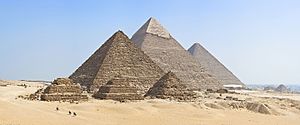
Back Piramides van Giza Afrikaans مجمع أهرامات الجيزة Arabic اهرامات الجيزه ARZ Giza piramidaları Azerbaijani جیزه هرملری AZB Гиза пирамидалары Bashkir Gizas pėramėdės BAT-SMG Піраміды Гізы Byelorussian Піраміды Гізы BE-X-OLD Пирамиди в Гиза Bulgarian
 The three main pyramids at Giza, together with subsidiary pyramids and the remains of other structures | |
| Location | Giza, Greater Cairo, Egypt |
|---|---|
| Region | Middle Egypt |
| Coordinates | 29°58′34″N 31°7′58″E / 29.97611°N 31.13278°E |
| Type | Monument |
| History | |
| Periods | Early Dynastic Period to Late Period |
| Site notes | |
| Website | |
| Part of | "Pyramid fields from Giza to Dahshur" part of Memphis and its Necropolis – the Pyramid Fields from Giza to Dahshur |
| Includes | |
| Criteria | Cultural: i, iii, vi |
| Reference | 86-002 |
| Inscription | 1979 (3rd Session) |
| Area | 16,203.36 ha (162.0336 km2; 62.5615 sq mi) |
The Giza pyramid complex (also called the Giza necropolis) in Egypt is home to the Great Pyramid, the Pyramid of Khafre, and the Pyramid of Menkaure, along with their associated pyramid complexes and the Great Sphinx. All were built during the Fourth Dynasty of the Old Kingdom of ancient Egypt, between c. 2600 – c. 2500 BC. The site also includes several temples, cemeteries, and the remains of a workers' village.
The site is at the edge of the Western Desert, approximately 9 km (5.6 mi) west of the Nile River in the city of Giza, and about 13 km (8.1 mi) southwest of the city centre of Cairo. It forms the northernmost part of the 16,000 ha (160 km2; 62 sq mi) Pyramid Fields of the Memphis and its Necropolis UNESCO World Heritage Site, inscribed in 1979.[1] The pyramid fields include the Abusir, Saqqara, and Dahshur pyramid complexes, which were all built in the vicinity of Egypt's ancient capital of Memphis.[1] Further Old Kingdom pyramid fields were located at the sites Abu Rawash, Zawyet El Aryan, and Meidum.
The Great Pyramid and the Pyramid of Khafre are the largest pyramids built in ancient Egypt, and they have historically been common as emblems of Ancient Egypt in the Western imagination.[2] They were popularised in Hellenistic times, when the Great Pyramid was listed by Antipater of Sidon as one of the Seven Wonders of the World. It is by far the oldest of the Ancient Wonders and the only one still in existence.
- ^ a b "Memphis and its Necropolis – the Pyramid Fields from Giza to Dahshur". UNESCO World Heritage Centre. United Nations Educational, Scientific, and Cultural Organization. Retrieved 7 September 2021.
- ^ Some medieval visitors, however, viewed them as "the Granaries of Joseph", such as the Spanish traveller Pedro Tafur in 1436 (Pedro Tafur, Andanças e viajes).
© MMXXIII Rich X Search. We shall prevail. All rights reserved. Rich X Search
